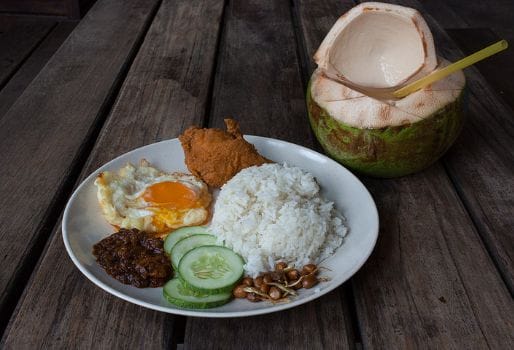Fragrant rice cooked in coconut milk and pandan leaves, served with a side of sambal (a spicy paste), eggs and anchovies, these are the components of a Nasi Lemak that make it a deliciously fulfilling meal.
Known as the national dish, it was once a simplified breakfast dish packed in banana leaves and sold for as low as 30 cents! Nowadays, its variations include a side of rendang (beef curry), curry chicken, fried chicken and other meat dishes, while Nasi Lemak has been conceptualised into burgers and even, ice cream.
It is evident that Malaysians love their Nasi Lemak, as stalls are scattered throughout the nation to satisfy cravings and it remains a staple in most local menus.
But, while its origins remain unconfirmed, here are three quick fun facts you may not know about this exceptional rice dish.

It's Healthy
Back in 2016, Nasi Lemak was recognised as one of the 10 most healthy international breakfast by TIME Magazine. Ironically, Nasi Lemak actually translates into “Fatty/Oily Rice” but its meaning relates along the lines of “creamy rice”. TIME Magazine had described the dish as “supremely delicious”, while stating Nasi Lemak was balanced with manganese, protein and carbs. Furthermore, it was written that the chilli in the sambal helps boost metabolism! Nevertheless, its fat content could not be ignored as the article wrote “there’s a bit more fat than is good for you”, and it was advised to reduce your rice intake for a healthier meal.

There is Folklore Behind the Rice
It was said that Nasi Lemak was born began in a small village at the home of a widow, Mak Kuntum and her daughter, Seri. Mak Kuntum worked as a masseur to provide for the family and her daughter would be left alone at home to attend to chores. From here, there are two variations to the story of how Nasi Lemak became about – one was that Seri accidentally spilled coconut milk in a boiling pot of rice, while the other was that she had mixed in pandan leaves and coconut milk out of boredom. The story continues with Mak Kuntum coming home from work and upon smelling the fragrant rice, she asked her daughter what it was, to which Seri replied “Nasi le, mak!” (rice, mother!), and that was how it got its name – Nasi Lemak. Of course, there is little concrete evidence to this story but nevertheless, it’s a fun story to tell.

The Original Version
The origins of Nasi Lemak can be traced back to 1909, when it was first mentioned in a book titled “The Circumstances of Malay Life”, written by Sir Richard Olof Winstedt. It is recognised as Malay dish and was popularised as a breakfast food. In the olden days, Nasi Lemak was paired with fried fish, kangkung and stir-fried sambal, while the rice would be cooked over an open fire and closely monitored to prevent the milk from overheating. Nowadays, the making of Nasi Lemak is less tedious as rice cookers have made its creation much easier, while it is generally paired with anchovies or anchovies-infused sambal variations.












